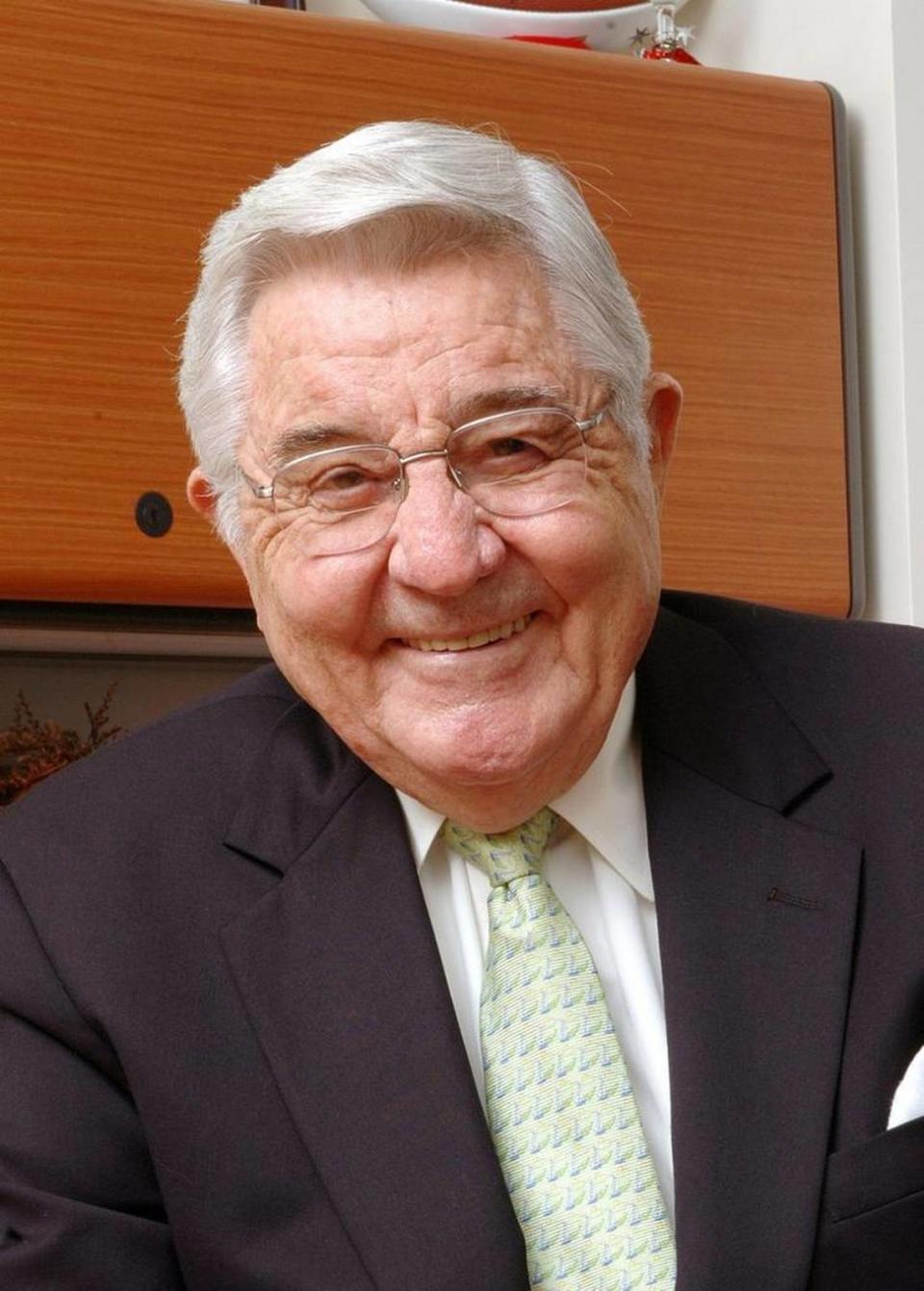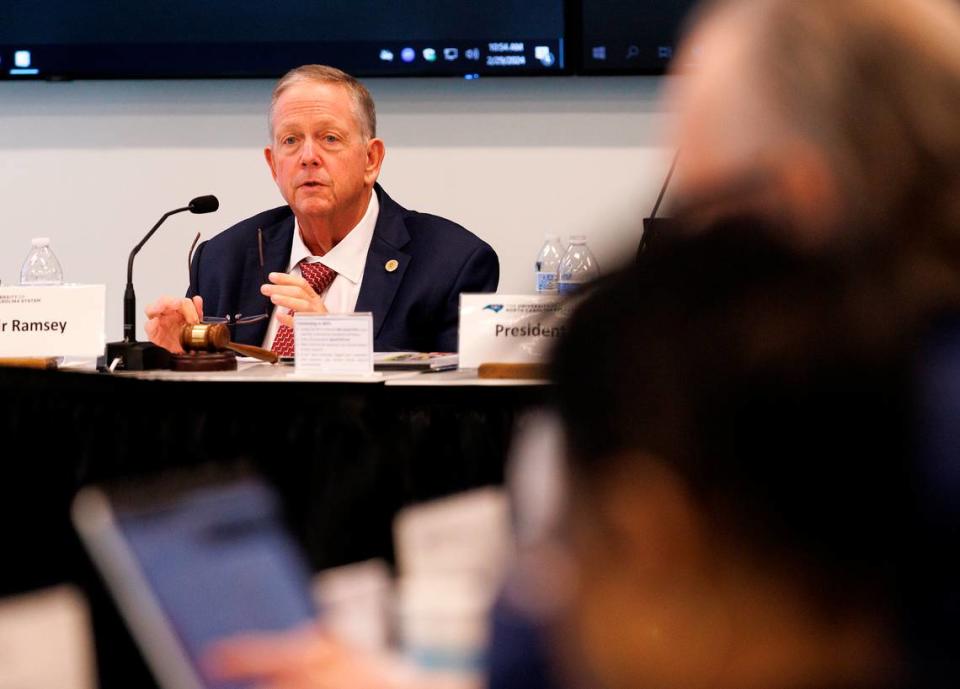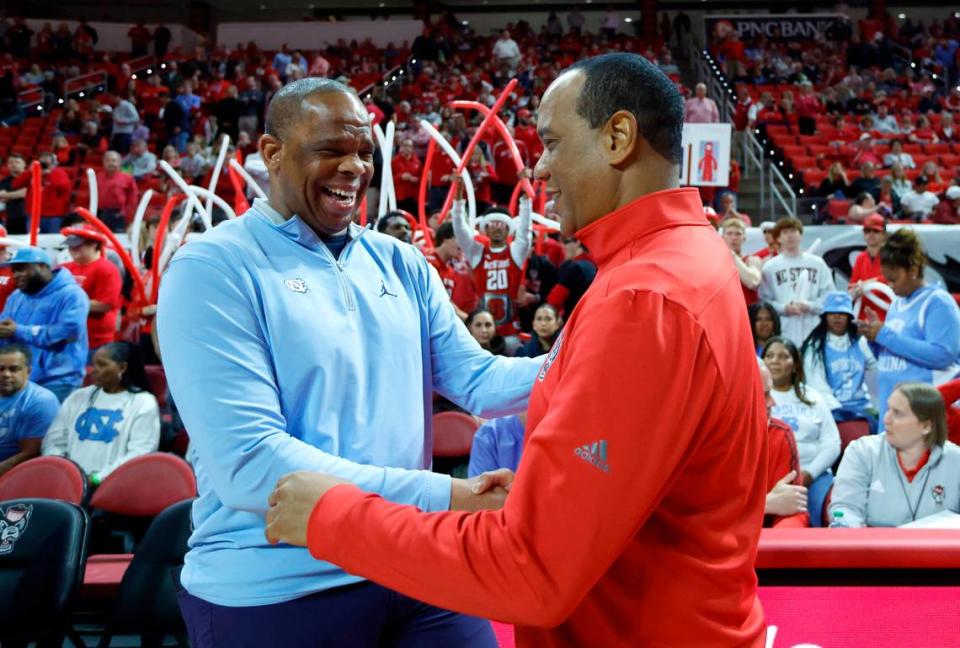UNC System has a say in conference moves, but college sports machine is unstoppable
The policy change that might help preserve the ACC and college athletics as they’ve been known in North Carolina passed Thursday morning without fanfare or discussion in a 17th floor boardroom in downtown Raleigh, with a portrait of Bill Friday on the wall just outside the back door.
It was fair to wonder what Friday might think of, well, just about everything in college sports these days.
Almost 12 years after his death, at 92, Friday remains synonymous with higher education in North Carolina. He served as the University of North Carolina System President for 30 years, beginning in 1956, and transformed it into a national model. He became, too, one of the nation’s foremost critics of big-time college athletics.
Perhaps Friday might’ve been proud on Thursday, after the UNC System Board of Governors approved a policy change that essentially gives the board, and its president, the power to stop state universities from moving to a different athletics conference. Perhaps Friday would’ve wondered, instead, whether it’s worth the effort to preserve anything about college sports as they are today.

Friday often questioned their relationship to the educational mission of universities. He bemoaned the influence of television and commercialism. He helped found, in 1989, three years after his retirement from the UNC System, the Knight Commission on Intercollegiate Athletics, which began with the hope of bringing major reform to college sports.
So much for that. Friday tried, at least.
NCAA musical chairs
The college athletics world that Friday knew has grown only more unruly and unrecognizable. Some of the mayhem — that surrounding the combination of NIL and the transfer portal, in particular — is attributable to changes that were long overdue, but ones the NCAA implemented, in typical fashion, without vision or much of a plan.
Then there’s major conference realignment, and the craven pursuit of more. Some of the wealthiest conferences and wealthiest schools and wealthiest administrators in college sports have decided they don’t have enough. Their pursuit of more — and “more” will never be enough — has led to the destruction of the Pac-12 and a dreadful, comical game of realignment musical chairs.
It’s why Texas and Oklahoma are leaving the Big 12 for the SEC. It’s why the Big 12 has become an odd mishmash of institutions bonded by their common desire to keep a seat at the table. It’s why USC and UCLA and Washington and Oregon are headed to the Chicago-based Big Ten. And why the ACC, after an expansion of desperation, awaits the arrival of Cal, Stanford and SMU.
There was some comedic juxtaposition Thursday when, hours after it officially became more difficult for North Carolina universities to switch conferences, the ACC unveiled its 2024-25 conference match-ups in men’s basketball. In the very old days of the ACC, such a thing would have been unnecessary, because each ACC team played every other conference team twice.
Now, though, with the ACC becoming an 18-team league in basketball, figuring out who will play who can be confusing and unwieldy. Thus the conference’s release on Thursday of a match-up grid, which underscored like few things can the absurdity of where we’re at in college sports.
It revealed several gems: that while N.C. State and Duke won’t play twice, State and Cal will. That while Virginia won’t play any North Carolina school twice, it can look forward to two games against SMU. That Syracuse must’ve made the ACC angry (was it Jim Boeheim’s quips about Greensboro?) given the Orange will go on the road to SMU, Cal and Stanford — as well as to Miami, Florida State and Clemson.

‘The landscape has completely changed’
Whether its leaders want to admit it publicly or not, the insanity of realignment is part of the reason, undoubtedly, why the UNC System, the governing body of state universities, has given itself some authority over conference affiliation. Schools and leagues have proven they can’t help themselves. If there’s more television money to be made, there’s no limit to what they’re willing to accept; no reluctance to leave behind the history and relationships that allowed their rise to prominence in the first place.
In explaining the Board of Governors’ decision to insert itself in any potential realignment moves among state universities, Peter Hans, the UNC System President, noted that it’d been a while — more than 20 years — since the system had updated its athletics policy. And since then, he said, “the landscape has completely changed.”
“There is a well-established role for the Board of Governors” in athletics, Hans said, noting its authority in approving funding for facilities and approving student athletics fees, among other charges. “But what hasn’t really been addressed is the fact that over the past decade, I believe, seven of our institutions have changed their athletic conferences, one institution twice in that time.”
Those moves, Hans said, can have “a significant financial impact on the institution.”

In the past decade or so, ECU has gone from Conference USA to the American Athletic Conference. Appalachian State has entered into the Football Bowl Subdivision (formerly Division I-A), and joined the Sun Belt Conference. Charlotte has gone from the Atlantic 10 to Conference USA to the American, after starting a Division I Football Championship Subdivision (formerly I-AA) football program in 2013 and moving to the FBS in 2015.
Some of those moves, Hans said, resulted in students paying higher athletics fees. And then came the more major realignment nationwide, and the resulting domino effect that now threatens the long term survival of the ACC. Jim Phillips, the league’s commissioner, went from advocating in 2022 for a “healthy neighborhood” throughout major college athletics to his push, a year later, for the ACC to add some of the scraps from the scavenged Pac-12.
The hope, for the ACC, is that expansion might offer stability. And yet it might prove too little, too late to stop the Big Ten or SEC from poaching whatever ACC schools they desire. Those two conferences never cared about being a part of a healthy neighborhood; they cared, their actions have proven, for years, only about growing larger and wealthier. At the least, the UNC System Board of Governors has now made it more complicated for UNC or State to switch conferences.
“Yes, much of the current conversation was generated by the ACC moves,” Hans said, referencing the additions of Cal, Stanford and SMU. But, he went on, the consequences of realignment, regardless of the level of the conference, “matters to every institution within the system.”
‘It’s our responsibility’
What’s less clear is how the UNC System’s new policy would play out, in reality. The policy now requires any state school considering switching conferences to provide “advance notice” of the potential move to the UNC System president. That requirement would prevent in North Carolina the kind of scenario that transpired in California, where state higher education leaders appeared blindsided by UCLA’s announcement in 2022 that it was leaving the Pac-12 for the Big Ten.
The Regents of the University of California — that state’s equivalent to the UNC System — considered retroactively blocking UCLA’s move before approving it. In doing so, though, the regents also mandated that UCLA pay Cal millions annually, as a kind of monetary penance for leaving behind a state-funded rival to join a wealthier conference.

“I don’t think any of us were concerned about being blindsided by one of our campuses,” Randy Ramsey, the chairman of the UNC System Board of Governors, said Thursday. Before becoming the board’s chair in 2021, Ramsey, a Beaufort businessman who founded a company that builds custom sport fishing boats, was perhaps best known for being a prominent N.C. State booster.
He and his wife, Tiffany, were honored at a 2016 N.C. State men’s basketball home game after donating the “single largest athletics endowment gift in Wolfpack Club history,” according to an N.C. State press release at the time. The Ramseys endowed scholarships for the N.C. State men’s basketball team, and at the same time gave “the single largest gift to the Equine Sports Medicine Program in the College of Veterinary Medicine.”
Ramsey has also held leadership positions in the Wolfpack Club and served on the N.C. State Board of Trustees. He said Thursday that the broader implications of conference realignment — how one school’s potential move might affect another school — “certainly could” be a part of how the Board of Governors evaluates any institution’s proposal to join a different conference.
In addition to the requirement of “advance notice,” schools planning to switch conferences must also provide the UNC System president with a financial plan detailing the implications of the move. The president can then either reject the plan or bring it to the Board of Governors for a vote. If rejected, the school could then resubmit the financial plan, restarting the process.
“We’ve got several of our schools that are in the same conferences, and (a move) could affect those conferences” Ramsey said. “But I don’t know that we would be concerned necessarily about globally how it affects a conference, or how it affects anybody other than our schools.
“I do believe that we’ve got 16 universities that we are responsible for and responsible to. And it’s our board’s mission to ensure that they’re safe, and that they do the right things, going forward.”
Indeed, said Hans, who was listening to Ramsey, “it’s our responsibility.”
Change is a constant
Both Hans and Ramsey have far more important responsibilities, but college athletics is a part of the cultural fabric of North Carolina in a way that it isn’t in most states. There is all the history and prestige here in college basketball. And also the proximity of the four ACC schools, with three of them separated only by county lines, different colors and short drives.
In the weeks and months before the Board of Governors approved the policy change that gives the UNC System more of a say in conference realignment, an obvious and expected perception emerged while the measure was under consideration: that it was really a way to tie UNC and N.C. State together, and ensure they remain in the same league.

The universities were both founding members of the ACC in 1953. They were founding members, too, of the Southern Conference in 1921. Among the other schools that founded the Southern Conference were Alabama and Auburn, which left to help start the SEC, and Washington and Lee, which eventually gave up major college sports and is now an NCAA Division III school.
The only constant in college athletics has been that kind of change, with conferences rising and falling and schools coming and going, though it has been a long time since any university de-emphasized sports the way Washington and Lee did, or the University of Chicago before that. It’s fair to wonder whether that’s even possible now, with schools committed to the chase.
For years, the most efficient way to evaluate a school’s commitment to that chase was to look at its facilities. It was to consider the palatial football stadiums or shiny locker rooms or, in the case of Clemson not that long ago, the lazy river or barbershop (or putt-putt course) of a football facility. Now, though, schools don’t want to reside in the healthiest neighborhood, but the richest.
And thus the rush to join the Big Ten or SEC, and the reason behind Florida State’s attempt to litigate its way out of the ACC as soon as possible.
‘We will remain nimble’
The ACC, meanwhile, is hardly free of blame. The conference abandoned its own roots in moving its headquarters to Charlotte last summer and, long before that, its pillaging of the old Big East set in motion a lot of what continues today.
Of the eight schools who joined the league in 1953, six remain. Next year, they’ll represent one-third of the conference’s membership. There will be as many ACC schools in California as there are in Virginia, and the uncertainty surrounding the league will endure as long as there’s some kind of finality — whether in mass defections or some kind of reaffirmed stability.
UNC and N.C. State, like every other school outside of the Big Ten and SEC, have been left to navigate the chaos. The UNC System’s latest policy change adds another layer to any move they’d make, or try to make. Hans, the system president, noted how both schools were on opposite sides of the ACC’s vote to expand — UNC opposed, N.C. State in favor, eventually.
“There’s no binding here,” he said. “Surely, though, we are all partial to the traditional Tobacco Road rivalries, with Carolina and State and yes, even Duke and Wake in that regard. And I hope they’ll continue.
“Now, no one can fully predict the future of college athletics and, as thus, we will remain nimble. But the foundational principle here is protecting the students and the families and the taxpayers against decisions which have significant downstream financial impacts.”
It was not the first time that a UNC System President had tried to assert power and control over the unintended consequences inherent throughout college athletics.
Friday fought the good fight, for decades, and warned of the corrupting influence of television and money. Indeed, that fight became part of his legacy, just as the forces he opposed grew more impossible to stop.

